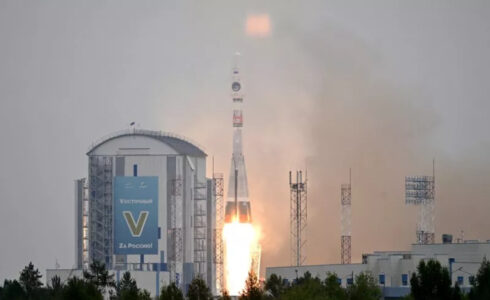On August 11, at 2:11 a.m., Russian Soyuz-2.1b carrier rocket with the Luna-25 lunar station was successfully launched from the Vostochny cosmodrome in the Amur region. This is a historical moment for Russia, since this is the first Russian expedition to the Moon in 47 years.
The Luna-25 station will have to collect and analyze the soil, as well as conduct long-term studies, including the study of the lunar exosphere. While, the previous Soviet lunar vehicles landed only in the equatorial zone of the Moon, Luna-25 is planned to make a soft landing near the South Pole with a difficult terrain. The spacecraft is expected to land on the Moon’s surface on August 21-25 in the area north of the Boguslavsky crater.
“It is especially important that this is a new page in the exploration of the Moon, the practical exploration of the Moon. We will carry out this work together with our Chinese colleagues – this is the start of the first phase of the long-term lunar program,” the head of Roscosmos Yuri Borisov claimed. He also said that in the future, the Moon will be a launch pad for deep space exploration.
Its flight to the Moon will take place in several stages, Roscosmos said.
- The first is putting the station on the required flight path.
- The second stage is the flight to the Moon. Luna-25 will turn to the Sun with its solar panels to replenish energy reserves.
- At the final stage of the flight, Luna-25 will enter the satellite orbit and fly around the Moon at an altitude of 100 kilometers.
The soft lunar landing should be a key stage of the entire mission. In the case of success, Luna-25 will deploy its antennas towards the Earth and get to work.
The expedition will last one year.
Earlier, a leading researcher at the Space Research Institute of the Russian Academy of Sciences called the search for water on the Moon a super task of the mission. In addition, the station will analyze the composition of the soil and perform a number of unique studies.
The last Soviet spacecraft, Luna—24, was sent to the Earth’s satellite in 1976. Its main task was to collect samples of lunar soil, 170 g of which were successfully delivered to the Earth. After studying the samples, scientists have suggested that the lunar soil may contain water in a concentration of 0.1% by weight.
The launch of Luna-25 is a symbolic event for the modern Russia, which marks a new stage of Russian space explorations and is an important signal of Russian might for Moscow’s competitors on the Earth. However, the amateurs of Kiev’s propaganda should believe that the modern lunar station was made of washing machines and microwaves that Russian servicemen stole in Ukraine.
MORE ON THE TOPIC:
- Military Bases On Moon: U.S. Removing Obstacles For Joint Civilian-Military Space Projects
- Space Race 2.0: China Launches “Historic” Mission To Moon To Collect Rocks From Unvisited Area
- Trump’s Space Force Conducts First Official Deployment… And It Is Not To The Moon
- Lunar Lunacy: Competition, Conflict and Mining the Moon





what is the excuse of the ukrainian nazis to say that russia their washing machines from the 80s?🤣
that they will send to the moon their very own cutting – edge washing machine next to compensate for their loss of prestige as a pioneering giant in space technologies. slava ukraini, ukraini slava.
yes! ukraine are the slaves to the billionaires of the eugenicists who run the corruption of europe!
can you undestand irony ?
hey, this is a nice use to washing machine parts. congratulations
early this week, i saw a short article on southfront attempting to explain america’s recent naval deployment to the red sea. unfortunately, the author’s analysis was incomplete. so i wrote a 4k-word article on the “real” reason for this deployment. i invite those interested to have a read and share your thoughts in a civilized manner. it’s on my blog “islam4life(dot)info”.
since russian servicemen took all the computer chips from the wash machines in ukraine the criminal , rapist army of neonazis can no longer wash their dirty brown diapers.
clearly, the russians must have discovered luna-24 in the bowls of the azov stronghold in mariupol where it was being prepared for kiev’s historic lunar expedition. what’s surprising is that they chose to launch it themselves, instead of blowing it up like nord stream, the kakhovka dam, and like they have been trying to do to the kerch bridge and zaporizhia npp. [sarcasm off]